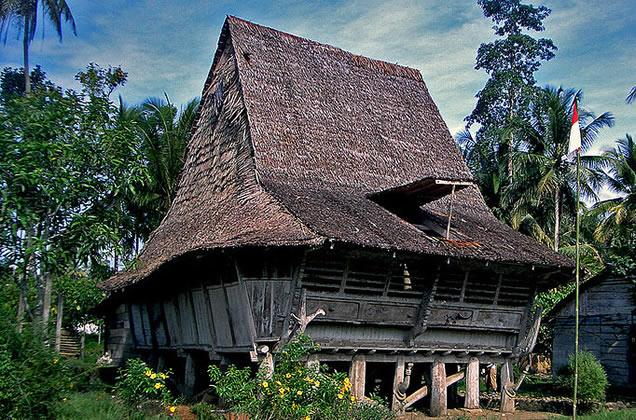I stay a couple of days in a village in Sumatra, Indonesia. Houses are situated each side of the long, dusty track, which is about a car’s width. The start of the village meets the facilities of the main road: shops, food stalls and mosques. The end meets the cemetery. The houses are mainly bungalows, with cemented front rooms and back kitchens, sheltered under a mix of tiled and corrugated iron roofs. The sound of sweet tranquillity is occasionally interrupted by the roars of motorbikes and the squeals of children running around or playing games, barefooted.
I stay with a middle-aged widow, Kak, and her elderly mother. During my stay, her brother, sister-in-law and two little nephews visit us. They come from Kak’s home village, over two hours away. They travel on a motorbike: the father is the driver; the mother sits behind him with their baby in between. Their toddler is perched in the front.
Kak’s living room is bare except for four blue plastic chairs with a matching coffee table, a straw mat, a television and a wooden cabinet. I tend to sit on the chairs but I feel uncomfortable as everyone prefers to sit on the floor. She has three bedrooms, only one of them has a bed, which I sleep in. The other bedrooms have mats and duvets in them. Her kitchen has two gas rings for a stove and a fridge-freezer (being one of the few houses in the village that has such a luxury). Her water comes from a well in her bathroom, next to the kitchen. Her toilet is a squat-toilet with no flush. Her shower is a big bucket of water, and a smaller one with a handle to help douse oneself with. Kak grows vegetables and fruit in her garden, and she keeps chickens and goats. She sells cocoa to her neighbours, as well as the ice from her freezer.
Kak, having lost her husband only three years ago, sometimes feels lonely but she is never alone. Neighbours stop by to greet or take her to the shops; children play in her front patio; her adopted son pops over for a visit, welcoming me with banana fritters.
Compared to living standards in Belgium, Kak is poor. Yet, I highly doubt that she is any less happy than I am. Life in this little village seems basic– people have just enough to get by and have little access to higher education or good healthcare. Yet, there is a strong sense of community: neighbours help each other out, buy and sell things to one another, give each other lifts on their motorbikes.
Seeing Kak feed her goats got me thinking about materialism and happiness. Does more money really make us happier? In her book Flourishing clinical psychologist Dr. Maureen Gaffney highlights studies stating that beyond a certain level of a household’s salary (for example, enough to provide decent accommodation, food and education), this isn’t true.
Neither does the latest technological device or car increase our happiness. According to the University of Berkeley’s Greater Good Science Centre in the article ‘How Gratitude Beats Materialism’, the more materialistic a person is the less happy they are likely to be because they tend to place their happiness in novel goods or things. Once the novelty inevitably fades, so does the supposed happiness. They then move on relentlessly and fruitlessly to the next bigger and better thing. Instead of appreciating the present, they take it for granted and yearn for the future. As the stoic philosopher Seneca said: “The greatest hindrance to living is expectancy, which depends upon tomorrow and wastes today.”
In The Antidote: Happiness for People Who Can’t Stand Positive Thinking, Oliver Burkeman looks at how a bit of negative thinking might help us be happier, and that too much positivity may make us feel worse. For his research, he visits Kiberia, a slum outside Nairobi, infamous for its “flying toilets”. He finds that despite rampant HIV, no running water or electricity and high crime, its inhabitants appear to be pretty happy. Burkeman argues that it would be wrong to attribute their happiness to the patronizing and prejudiced stereotype that people in underdeveloped societies are ‘simpler’. Rather, Burkeman concludes that Kiberia’s residents accept that life is insecure and unlikely to change. As he notes, “It’s not at all OK that there is severe poverty and disease, but you do get one thing from living without the privileges we have: you don’t have the option of mistakenly believing the next car or next apartment is going to bring lasting happiness forever. You don’t have the luxury of falling into that delusion so you face the world as it is.”
Materialism, comparison, obsession with wealth and security certainly adds to the unhappiness of those of us who live in more affluent societies. Practising gratitude can counteract such feelings or state. Staying with Kak made me realize that I don’t need much of anything to be happy. There is, however, one exception. On a daily basis, Kak made connections with her family, friends, neighbours and animals. In our more developed societies, we are becoming increasingly starved of connection, having to make do with social media as a substitute. “Love people, use things,” goes a formula for happiness suggested by the New York Times. Perhaps it’s that simple.
Photo house: Monica Renata
Photo Minangkabau women: Marc-Antoine Dunais







